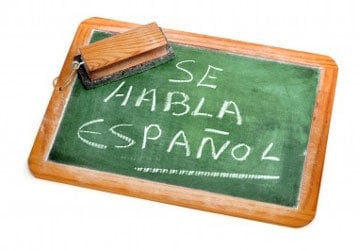Best Way to Learn Spanish: Beginners Guide [Immersion, Books, Classes]
Looking for the best way to learn Spanish? This guide will help you learn about the primary ways to learn Spanish, and help you choose the one that’s best for you.
In this guide, you’ll also get the resources and Spanish basics to learn Spanish for beginners. Author is an English-speaking Canadian who moved to Ecuador with no Spanish (and is now fluent).
Ready to learn Spanish? Congratulations! This is a huge step. Whether you’re planning to move abroad, travel to Latin America (or Spain), or simply as a mental exercise, this guide will help you learn Spanish quickly.
While there are lots of variations, there really are just 3 ways to learn Spanish: immersion, self study, and classes. And these can be combined to match your learning style.
While classes and books are a common method, there is an easier way to learn Spanish.
Storyteller.travel shares the best travel insights, facts, and photos. When you use our links, we may earn an affiliate commission. Learn more.
The Easiest Way to Learn Spanish
The easiest way to learn Spanish is to learn it through immersion as a child. Either grow up in a home that speaks English and Spanish – or live in a community where your daily life is primarily (even exclusively) in Spanish.
When we moved to Ecuador, our daughter was 8 years old. She learned Spanish, almost free of language books and teachers. If you have the option to immerse your kids in Spanish – this is going to be the easiest way for them to learn. They learn and become fluent without them even realizing what’s happening.
Now if only it was that easy for adults…
The Best Way to Learn Spanish
So while immersion as a child is hands-down the easiest way to learn, that just isn’t possible for most of us. If you’re reading this – you’re probably in the same situation as me. I grew up with almost zero exposure to Spanish – with the exception of these few words: salsa, fiesta, siesta, and gracias.
I didn’t know anyone who spoke Spanish – let alone someone who was actually from a Spanish-speaking country. Back in the 80’s and 90’s there weren’t many (any) Spanish songs on the radio.
And in Canada, the only other language that most Canadians are exposed to is French (the other official language) and even that is limited.
My French is limited to “Parlez–vous français ?” (meaning: Do you speak French?) to which my answer is an unfortunate “No” (this is the same word in French, Spanish, and English).
So how did a couple of red-necked Canadians learn Spanish? It actually wasn’t as hard as we had imagined.
Here’s how we learned Spanish:
The Best Way to Learn Spanish
For us, the best way to learn Spanish was a combination of immersion in Ecuador and printed books and audio courses. We did take an intensive week of Spanish classes in Cuenca – but this didn’t really make much of a difference.
Dena and I tried to learn Spanish from books before moving to Ecuador – but it didn’t work so well. We found it hard to be motivated while surrounded by native English speakers. And we didn’t really know if our pronunciation was even close to how it was supposed to sound.
Regardless of your background and where you live, you have three different ways to learn Spanish.
3 Primary Ways to Learn Spanish
Here are the three ways to learn Spanish.
- Spanish Immersion: This is most easily done if you move to a Spanish-speaking country where your mother tongue is not commonly spoken. But there are some things you can do even in your hometown. – Jump to the Spanish Immersion section for more.
- Spanish Books and Courses: (Self Study) Purchase a book, audio course, or online course and progress through the chapters/lessons yourself. It is important to include an audio component – otherwise you won’t know how the words are actually supposed to sound. Jump to the books and courses section.
- Spanish Classes: (Online and In-Person) You can take a class in your hometown, take a trip to a Latino country, or study online. There are numerous online schools that give one-on-one tutoring – teaching a progressive curriculum. Jump to the Spanish classes section.
Now, let’s cover each of these in more detail.
Jump to the Spanish Resources and Spanish Basics sections.
1. Immersion: The Best Way to Learn Spanish?
When we moved to Ecuador in 2009, neither Dena or I could speak Spanish – let alone understand it.
We could say “buenos dias” – but not correctly, and we didn’t even know when we were supposed to say it.
While we did receive help from another expat family (with whom we became close friends) we quickly found that we both needed and wanted to be self-sufficient. It doesn’t feel good to need help to do every single step of daily life.
Within 6 months, we were able to deal with rental contracts, and after 18 months we moved from Cuenca (population of 300,000) to the rural town of Santa Isabel (population 18,000). At that time, we were the only foreigners living in the region.
Thanks to this total immersion, we saw our Spanish reach fluency level. But this type of a move isn’t possible for everyone.
5 Tips For Spanish Immersion Without Traveling
What if you can’t move to a Spanish-speaking country? You can still benefit from immersion. Here are a few ways to be immersed in Spanish at home:
- Watch Spanish videos every day: I don’t mean learn-Spanish videos – I mean just watch videos on any topic, in Spanish. For example, if you’re interested in gardening, you can Google Translate “gardening” and you’ll get “jardinería”. Copy and paste that word into YouTube and you’ll get an endless supply of Spanish videos about a topic that you enjoy. Just set up a playlist and listen away. This will give you the flow of the language and the vocabulary in topics that interest you. More about using Google Translate.
- Write in Spanish every day: Engage your mind by writing in Spanish for just a few minutes each day. You could journal about your day or maybe just a sentence containing a word that you just learned. This habit has the power to reinforce the words and phrases that you’re learning and help you to begin to think in Spanish.
- Try to think in Spanish each day: This one will be a little difficult at first, but if you make this a practice you’ll find that your skills will quickly improve. Here’s how to do it: start by asking yourself a question and then try to answer it in Spanish. It could be simple (What is your favorite color?) and gradually more complex (What did you do on the weekend?). This uses a different part of your brain – and helps to connect the grammar and vocabulary that you already know into coherent, meaningful phrases.
- Listen to Spanish audio: This can include radio (TuneIn), audiobooks (like Audible) and podcasts. What you listen to isn’t super important – as long as the topic interests you. As with Spanish videos, listening to Spanish audio will help you get the sound of the language in mind and improve your vocab and grammar.
- Read your favorite book in Spanish: Many top titles have been translated into Spanish. Because you already know the plot and characters, it’ll be easier to understand what you’re reading – even if you are just starting to learn Spanish.
Realities of Total Spanish Immersion

Well that’s is true, but what you often don’t hear about is how challenging it is!
When a family is plopped down in the middle of a total Spanish immersion experience it’s not all fun and games. Especially if you don’t speak the language, which was the case for our family.
We learned a lot about how family members react differently to an immersion environment, how kids can tend to act out because of it, and how it pulls a family even closer and makes them stronger.
There are a number of different learning styles, and you can have a good mix of those within your family unit. Some people will learn faster than others, speak more, but have pronunciation problems, others will learn slower, speak less, but pronounce very well. Learning to recognize learning differences and support one another is extremely important.
There will most likely be bouts of discouragement. We learned that the best way to deal with them is by being understanding and giving lots of encouragement.
Something that has helped me is Pimsleur Language Programs. If you just want to give it a test, get a 7-day trial for free. After that, there is a monthly subscription fee. Which is just a fraction of in-person classes – with full flexibility of where and when to study. With work, homeschooling our daughter, along with all the other mom-stuff it hasn’t always been easy to find time to study.
So being able to listen while washing dishes has been a great way to keep up with my Spanish. In addition to Pimsleur’s, we used many books to learn Spanish.
What has your total immersion experience been? Please share with us by commenting on this post.
Learn Spanish With Music
I recently found this great channel: Learn Spanish with Music on YouTube. They take popular Spanish songs and translate them into English and display the lyrics in both languages at the same time.
Just pick your favorite song and start learning.
With some creativity, you can create an immersive setting for you to learn Spanish – even if you can’t move to a Spanish-speaking country right now.
2. Self Study: The Best Way to Learn Spanish?
Buy a book and learn a language. This seems to be the most popular first step in language learning. Our readers have purchased many thousands of books over the years.
What are the best books for learning Spanish? I can recommend the following 3 books (links to Amazon):
- Madrigal’s Magic Key to Spanish: A Creative and Proven Approach
- Practice Makes Perfect Complete Spanish All-in-One
- Breaking Out of Beginner’s Spanish
In addition to printed books, it’s important to have an audio component. Without this, how will you know how to actually say the words?
What are the best courses for learning Spanish? Here’s the one our readers keep recommending:
- Pimsleurs: Pimsleur Spanish is an audio-only course that is done in just 30 minutes per day. Because it is audio-only it can be done during the morning commute, a work-out routine, or an afternoon walk with the dog. Get a 7-day free trial. Or read our review.
Over the years, we’ve written quite a lot about Spanish books and courses. Here are some of our most popular guides to books and courses for learning Spanish:
- The Best Book to Learn Spanish: There are countless books for learning Spanish. To determine the best book, we let our readers choose. The most popular book – for many years – is Madrigal’s Magic Key to Spanish. Read our review. It breaks the language into components with many logical and memorable shortcuts. This post lists the top 11 books for learning Spanish.
- 11 Books and Courses We Used to Learn Spanish: This is the list of books and courses that we purchased – including books, audio, and software.
3. Spanish Classes: The Best Way to Learn Spanish?
So while it’s nice to learn through situational conversation, having a live teacher can be beneficial.
They can give you a structured, progressive program. And the teacher will correct your errors – helping you from establishing bad habits.
There are a few ways to take Spanish classes.
3 Ways to Take Spanish Language Classes
- Community Colleges: Community colleges occasionally offer night classes – this might be a good introduction to the language. But don’t expect too much. The other students might just be looking to learn how to order drinks for their upcoming trip south.
- Online Language Classes: This is convenient because you can study from your home or office on your own schedule – no travel necessary. Usually, you will pay per session or for a set of sessions. The feedback from your instructor can be super valuable as you progress with the language. Most of these platforms employ native speakers with a rating system – to ensure you get a good teacher.
- Language Classes Abroad: This is the best option if you can arrange the travel. Not only will you study in person with a native Spanish teacher, but you will also continue to practice during your off-time because you are living in a Spanish-speaking country. The cost is surprisingly low.
Spanish Schools in Ecuador
- Simon Bolivar Spanish School
- Si Centro Spanish School
- Andean Global Studies – AGS: Schools located in Quito, Amazon, Montañita, Cuenca and Manta.
While we did take a class, it was just one week. It was beneficial to get some help fine-tuning our fluency and grammar.
But to get the full benefit of these classes, I think we should have studied at the school for a few months. Life got too busy, and we didn’t feel that we had enough time for that.
Learn about all the Spanish-speaking countries.
Spanish for Beginners (Resources & Motivation)
Here are some Spanish Resources (best books and courses) and Spanish Basics (introductory concepts) that are perfect for beginners.
Spanish Resources
To get started, I recommend that you check out this post: The Best Book to Learn Spanish These are the books that readers just like you are using to learn the language.
Free Spanish Resource
Free Resource: I recommend that you get Audible lessons 1-5 (free when you signup here). You can try it for free and see if it works with your learning style.
Spanish Basics
Here are some Spanish basics to help your get started.
Spanish Basics: Videos
- How to Say the Letters and Sounds in Spanish: This video will teach you the basic Spanish letters and sounds in less than 12 minutes. This is both a great introduction and review.
- When Do I Use the Spanish Tú or Usted?: Both tú and usted are Spanish for the word: you. Unlike in English, the word “you” in Spanish comes in two varieties: tú (informal) and usted (formal). And while the rules might seem straightforward, it won’t be intuitive for native English speakers.
- How to Pronounce the Letters B and V in Spanish: In Spanish, the letters “b” and “v” can be confusing to us native English-speakers. They sound very similar and can confuse even fluent Spanish speakers.
 Basic Spanish Phrases
Basic Spanish Phrases
- How to Order Food in Spanish: Simple Phrases and Questions: Here are the basics of ordering food in Spanish in a video. You’ll also learn 11 Phrases to Know When at a Restaurant: These phrases are spelled out phonetically to help even the newest Spanish speaker successfully order their meal.
- 9 Phrases to Know When Your Arrive at the Airport: Imagine that you just landed in a Spanish country. These are the phrases you’ll want to know.
- How to Say “I love you” in Spanish. As you settle in with your new language, you’ll want to express your feelings.
Should You Learn Spanish Before Moving Abroad?
Although we didn’t speak Spanish when we arrived in Ecuador – I recommend that you have at least a basic knowledge of the language.
Being able to understand basic expressions will not only make your first few weeks and months easier – it will reduce anxiety should you have some type of emergency.
If nothing else, being able to tell the taxi where you’re going, understand how much money he wants, and then give directions back to your home is pretty nice.
9 Time-Finding Hacks for Language Learning
Are you learning a foreign language? One of the most frustrating things about language learning is finding the time for it.
Learning a new language can seem overwhelming, especially if you are only exposed to it when you leave your house to pick up your groceries.
But when you start listening to it in the shower, in the car, when you exercise… it stays fresh in your mind and you will be more comfortable to start conversations with native speakers.
If you’ve been having a hard time finding the time, this is the list for you!
My Top 9 “Time Finding” Language Learning Hacks
- Learn in the shower. I used to waste shower time just getting clean: how crazy was that!? Now I take a Spanish lesson every morning with a Bluetooth waterproof speaker, my tablet, and a Pimsleurs program. Get a 7-day free trial. When I leave the program running while I coat myself in sunblock, get dressed, and do my makeup, I cram in a 30-minute Spanish lesson. It’s wonderful, the Spanish goes in while my mind is fresh.
- Learn in the car. Make use of car time by listening to language learning programs. Everyone loves to listen to their favorite music while driving, but as an expat you need to cram in whatever time you can to learn. Trust me, when you start communicating more freely, you’ll be happy you didn’t just lazily listen to music all the time! 🙂
- Learn while doing chores. Do you ever wash dishes, vacuum the floor or iron clothes? Use that time! Listen to language programs on your iPhone, watch movies in the language you are trying to learn, listen to the local radio station…
- Learn while shopping. Use strangers (friendly strangers who have some time on their hands) to teach you the language. I do this all the time! When I’m buying at the market I point to something and ask (in Spanish) “how do you say that?” People are more than happy to help by providing the word I need to learn. I repeat it, if I say it wrong they help me until I say it right.
- Learn in the bathroom. This is not a big topic of conversation, but who does not read on the can (the loo, the head, the john, the toilet) once in awhile? Make use of that time. Keep some simple language books nearby. Kids learning books and readers are a good choice, they have pictures (which help with learning comprehension) and easy words. You can usually find them at bookstores, school supply stores and paper supply stores.
- Learn as you exercise. Do you run, jog, walk or bike? Take advantage of that time to listen to language learning programs.
- Learn as you socialize. Talk to whoever you can about (or in) the language you are learning. If you are at a lunch with expats, talk about what you’ve been learning. Chances are your friends will want to share what they have been learning as well. Talk to native speakers, taxi drivers, people behind you at the market, the person waiting on you at a restaurant, the girl next in line at the dentist office… just say what you know, ask simple questions, little by little you will advance.
- Learn on public transportation. Don’t let that time on the bus slip by. Listen to your program. Granted you may not feel like repeating out loud what you are learning, but you can repeat it silently to yourself.
- Learn as you fall asleep. Do you like to read as you fall asleep? Keep some of the same type of readers or learning books as mentioned in #5 near your bed. You will learn some simple sentence structure and common vocabulary.
Pay Attention As You Listen
If you really want to learn you need to pay attention as you listen. Just having something on in the background is not going to do much in the way of usable language. So focus.
Choose programs that allow time for you to respond or repeat what has been said before moving on. When you watch movies, have subtitles on in English. When you hear a phrase you want to be able to say, pause the movie, back it up and repeat it a few times.
Focused listening while doing other things will help you learn the language, but should not take the place of study.
Even if you just get up 20 minutes earlier each day to do some study, it will help and you will see improvement.
Your Turn
What will be the best way to learn Spanish for you? What method(s) are you going to use? Will you create an immersive environment at home? Or will you focus on self-study using books and audio courses?
Join us in the comments!








I originally planned to go abroad to study Spanish, but due to the impact of the epidemic, I was unable to do so. I like the author’s suggestion for online learning, it helps a lot in my situation.
I just found your site. I’m looking forward to spending time reading your content.
There are some great ideas in this article that I never would have thought of.
I’m a 72 year old single woman, no children with a Social Security income of about $830.00 a month. I’ve been researching various countries I could afford to live in. Ecuador seems like a place I could manage though I don’t have a clue (yet) of where in the country. I’m not interested in a big city though I do want to live car free and be able to do everything on foot, bike, bus.
There are other countries that seem possible, mostly in Asia but that seems like a big leap in distance and culturally at this stage and circumstances of life.
I’ve also been researching van living and making my way down to Ecuador to check it out before I make a decision… not that I can afford a van! Lol
My brother and SIL are considering Portugal but they are in a better financial situation than I am.Plus my brother is half Portuguese and because both his grandparents were born in Portugal he may be able to get citizenship there.
But I digress- which is my M.O.- sorry, all that verbiage was to get to the point that they are studying Portuguese on Duolingo which is free. ( https://www.duolingo.com/ ) So that is another resource to learn Spanish. I’m going to look into it and check into some of the posted resources here and try out some of your ideas.
Thanks for all the info you are providing.
Hello Diana,
I am a college student from Ecuador, I would advice you to consider coming when the covid-19 vaccine is out. I know that it is uncertain when that will happen, but in Ecuador for example it is really risky to move around the city by yourself due to the pandemic, and most people is trying to stay at home (except those whose jobs really depend on presential appearance). If you would like to come soon, I would recommend you to go to Quito (North) at least at first, as it is easier to get more services from mobile apps like Uber and other local delivery apps, and also because it is still really affordable. In case that you need specific medicines I would also recommend that you bring a good amount of pills as possible, because some specific ones, can get expensive here, as they are imported, but don’t let that scare you.
Quito is secure when you know the city, and that is not easy at first. So I would also recommend you to take some time to get to know the city before going out for some walks. As in all cities, Quito have secure and risky neighborhoods but it is easy to differenciate even with minimum guide. By March of 2020 Quito will inaugurate it’s first line of the Subway. This first line will allow everyone to travel the whole city in approximately 30 minutes, so it is really convenient to live close to the subway stations, the cost won’t be really expensive (There’s not an official price yet). Don’t get me wrong, there are multiple ways of getting around the city, in fact that is not a problem at all, but you should always try to travel in the safest way possible so you get the best experience possible of the country. Rent is relatively cheap so that isn’t something you should worry too much about, but I would recommend you to invest in a place where you would feel comfortable, even more in the case that you decide to stay at home until the pandemic is over. I would love to recommend you more things but there are so many things to say… But in conclusion, Ecuador is a paradise, life is calm and very very very helpful, so when you come you will see that most people will always try to help you. (Almost everyone, because there are some that try to abuse of the trust.) Being informed is your best tool to get the best out of Ecuador. I wish you the best of luck if you decide to come, if you need more advice, I will be looking into this page for some days… otherwise, that may be all.
Sincerely
S.R
I’m moving to Quito later this month from the U.S. because my husband is from there, and we’ve decided to move back so he can continue his family’s OBGYN practice. Unfortunately, I have very little background in Spanish and was wondering if anyone has any Spanish tutors they can recommend?
Thanks!
The school the this article recommended has online classes that fits your schedule http://www.simon-bolivar.com/spanish-courses-in-ecuador/online-spanish-lessons/
I am from India can u get quick knowledge of settle in equdor
Best of the best
I’ve learned Spanish about a year. Started from taking courses in college, but I felt frustrated right away. Then I found this course without difficult grammar and writing skills, mostly focusing on speaking. And that’s exactly what I was looking for! The most important thing of learning languages is knowing how to speak and using them to communicate with people. So if you didn’t find the right way to learn Spanish, this might be great for you. You can try 7days-free trial at beginning.